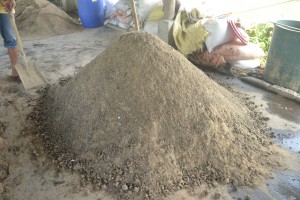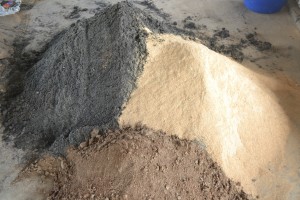The 1 Week Organic Fertilizer
August 26-2013
“Fermented Organic Matter” is the English translation from its Japanese counterpart. It is commonly called as “Bokashi” or the “1 week organic fertilizer”.
Bokashi refers to a fermented mixture of different kinds of organic matter with high Carbon and Nitrogen content incorporated with EM, molasses and water then fermented for just 1 week. Primarily, bokashi is used as a soil fertilizer because of its high N-P-K content with micro nutrients and it is packed with micro organisms. Aside from being a fertilizer, bokashi can also be used as a feed additive, composting agent, odor suppressant and ingredient for making EM mudballs.
Bokashi can be classified into two kinds: Aerobic (fermented with air) and Anaerobic (fermented without air). For this article, let us focus on the Aerobic fertilizer
So how do we prepare the Aerobic fertilizer? First, we need a few materials:
1. Materials with high Carbon content. Examples of this are: Rice bran(D3), Rice husk, Chopped rice straw or corn stalks, Wheat bran and Corn meal.
2. Materials with high Nitrogen content. Examples are: Soybean meal, Copra meal, Fish meal, Bone meal, Duckweed, Azolla, Ipil-ipil, Kakawate, manure
3. EMAS and Molasses – 1-5% of the total water volume
4. Non-chlorinated water – About 30% of Materials by weight (20-30L for 100kg materials)
5. Anything that can be used to cover the bokashi. This could be gunny bags, regular sacks, tarpaulin or even plastic. with plastic materials, it is advisable to punch holes in them so that air will pass through and can still induce heating
Procedure:
Step 1: Dilute EMAS and Molasses in water
Step 2: Mix all the solid ingredients and diluted EMAS solution
Step 3: Check for 30-40% Moisture content
Step 4: Cover the bokashi with gunny bags
Step 5: Ferment for 1 week in a covered area without rain and direct sunlight
There is, however, an added labor in the preparation of aerobic bokashi, since it ferments with heat, we do not want the bokashi to heat up too much. We need to maintain a temperature not more than 50 degrees Celsius by turning the bokashi pile over. Cover the pile after turning.
After 1 week, the bokashi is ready and one way to determine if its successful or not by its smell, it should give off a sweet-sour fermented smell and the temperature is stable meaning it should not be too hot anymore.
The bokashi is then ready for packaging and they can be stored into sacks. After collection, store the bokashi into a place where it is not under direct sunlight as this will evaporate the nitrogen content in the bokashi.
The potency of the bokashi will be based on the ingredients that you used so try and seek out better ingredients for your bokashi. The more ingredients, the better.

